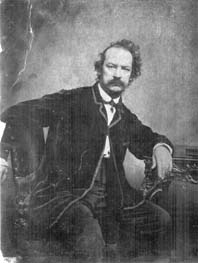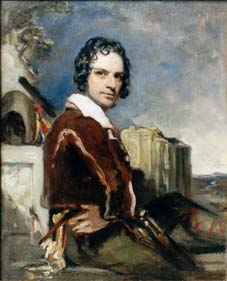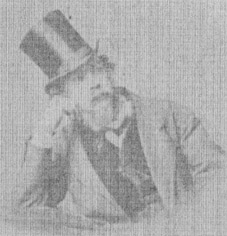 |
William Daniels, the Rembrandt of Liverpool |
William Daniels was my Great-great uncle and one of the genetic sources of my artistic ability. (Avis Saltsman)
Site last revised 17/1/2015

A photograph of about 1865 |

A rather sketchy self-portrait of about 1840, |
William Daniels, Painter (9-May-1813 to 13-October-1880)
For a good Victorian introduction to William Daniels' work,
download a .pdf file of William Tirebuck's essay by clicking here (52k).
Alternately, the whole essay is on this page.
The biography by way of an obituary published by the weekly "Liverpool Lantern" is on this page which is very large. Alternatively, you can down-load a .pdf file of it.
Some not very good black-and-white scans of photocopies of photos of Daniels work
Some not very good colour photos of Daniels work
More & better colour photos of Daniels work
And more colour photos of Daniels work here updated 17/1/2015
Photographs of places associated with Daniels
Source Book of obituaries and other notes 30-4-2001 More added
We owe thanks to the National Museums & Galleries on Merseyside
for the considerable help given us by Dr. Alex Kidson of the Walker Art Gallery
William Daniels family tree
Works on show
Meanwhile, there are three works on show in room 7 of the Walker Art Gallery, Liverpool. These are 'Joseph Meyer', 'Girl with a Pedestal' and 'The Card Players'. To see more, one needs to notify the gallery beforehand & arrange to see them in store there.
Sudley House, Liverpool, has 'The Image Seller' and the wonderful 'Gleaner' on view in the first floor main room.
Please e-mail us if you know of any others on public display.
The following correspondence from H. T. Kemball Cook to G. J. Binns about Daniels serves as an introduction to him:-
William Daniels, Painter
William Daniels was born about 1812, a native of the notorious Scotland Road district of Liverpool. His father had been a soldier who married a girl from a public house and set up as a brickmaker, a trade in which all the family had to help. Daniel's natural talent, wherever derived, shewed itself early, for he was forever trying to mould the clay and to draw faces on the soft surface of the raw bricks. This natural talent attracted the notice of one Mosses a wood engraver and he began at once to take an interest in the child. Attempts to make the boy's father believe that he might have a genius in the family could not be expected to succeed easily, but at last Mosses persuaded Daniels to allow his son to attend classes in drawing at the Royal Institution at Liverpool when not wanted for brickmaking. The good parent went further; he provided his son with a pair of clogs which were to embarrass William when he won, as he did very soon the first prize for figure drawing. He could not face the idea of having to clatter all the way up the hall in clogs to get his prize and was only reassured when a comrade offered to exchange footgear for the occasion. This seems to have been about the only occasion on which Daniels studied the conventions throughout his life.
Armed with this success Mosses persuaded the elder Daniels to apprentice his son to a wood engraver. Here William met with disappointment. He had supposed that his master would teach him the secrets of the brush as well as of the graver, but the master refused and Daniels was thrown back on his own resources and worked assiduously by candle light.
"Almost before he could have known the name and style of Rembrandt he fell naturally into the study of light and shade effects and henceforth his work bore traces of this early fascination. His last work is but a variation of his first." In his leisure he took to portrait painting. He made his first public appearance at the Liverpool Academy Exhibition when about 17, and it is said that comparisons very mortifying to his master were made between the master's work and that of the pupil.
Daniels' portraits and candle light effects rapidly won him local fame and he began to expand. "He took to self decoration and expressed his professional advance by much gaiety of costume and of life." Free of his apprenticeship he lived a boisterous life, working spasmodically but with increasing power. He made a romantic if improvident marriage, being reduced to painting his sweet heart as a gipsy pedlar and selling the painting off the easel to get money for the ring and licence.
Meanwhile he had read Shakespeare, Milton, Byron, Gray and some of the old comedies (discursively no doubt) and had become sufficient of a local celebrity to have his head turned. He drank heavily, consorted with pugilists, pedlars, tramps, mummers and so forth, sang a good song, never refused a dram and did much of his work for public houses. Good fortune brought him Sir Joshua Walmsley as an active patron and Daniels might have become famous had he cared for fame and rich had he cared for money. As it was he painted Charles Kean and Barry SuIlivan and the Walmsleys and Humphrey Davy and Geordie Stephenson. His loyal friends at Liverpool persuaded the Duke of Wellington to sit for him when visiting the city but Daniels' peculiarities asserted themselves, the Duke arrived punctually at the place agreed. Daniels did not arrive at all! On the other hand, if it be true that he was invited to paint the Prince Consort and refused roughly saying that he had no desire for a royal connection, it is possible to sympathise. Rembrandt and that quintessence of Coburg - the portrait must have failed; that task was best left to the Winterhalters whose brushes were lackeys. At the same time Daniels was increasingly difficult. "Matters had come to this - it was the patron who took off his hat to the painter and not the painter to the patron" The one anxiety of sitters was to catch him in a propitious mood for his inspiration was always fleeting and when out of temper he would slash a partly completed canvas or daub it with aimless strokes. Some of his patrons would put a few guineas on a convenient mantelshelf in the hope of attracting him, thus doling out the price as the picture went on. Money was lightly come and lightly go with him always.
Perhaps he was happiest when he was working at home by candlelight with a favourite music box playing beside him, but he painted also on panels and on beer barrels and the finest of his three Shylocks was painted on a common cloth and begun as a public house sign. His works were so eagerly bought locally that he exhibited little. He exhibited once in Manchester and once at Burlington House when the President of the Royal Academy paid him a special compliment. Brown's Gallery in Liverpool had his portrait of Mayer, an etching from which is in the British Museum.' He painted a number of self portraits but is a pity that the noble Walker Gallery in his native city does not (1882) possess a single one of these portraits. It would probably have become the nucleus of a collection of his work." There are five portraits by him at South Kensington including his Stephenson and his Charles Kean as Hamlet.
"The manner of Daniels is somewhat Dutch and his matter is that of a fiery poetical nature dwarfed by his own excesses, artificially excited but sombre with he shadow of his own tragedy. On but a few occasions has he done justice to his higher feeling and powers, rather choosing to deliver himself of prayerful nuns, beggars, single heads and moonlight effects than of Shylocks or of Prisoners of Chillon in which he proved himself a kind of master with a real capacity for graphic flash-like effects. He did not often venture beyond the single figure as though in dread of his own uncertainty of fervour and his greatest technical care has been devoted to still life subjects. Some of his works show a good sense of colour but on the whole this quality was limited and weak in him. It has been suggested that the vulgar associations of Daniels may have tended to dull his colour sense." (Surely this idea is great nonsense).
"That he was an artist with great dexterity of touch and excellent short cuts to expression, there is no question and the regret is that he was not more true to the faculty within him, that such powers as his should have been so unworthily employed and often so inadequately expressed. He had an eye for the beauties of life, but would not reach out for them. He left many works unfinished and even some of his best have indications of exhaustion, the fervour of his conception being often briefer than his rapid execution. This profusion of unfinished work with its possibilities and shortcomings is quite symbolical of his imperfect life and character."
He died 13 October, 1880 was buried in St. James Cemetery, Liverpool, and was followed to the grave by more than 200 mourners including many local notables.
(Signed H. T. Kemball Cook)

Another late photo
For a good Victorian introduction to William Daniels' work, download William Tirebuck's essay by clicking here (52k).
Alternately, the whole essay is on this page.
The biography by way of an obituary published by the weekly "Liverpool Lantern" is on this page (not finished yet).
His family tree
Daniels Family
Much of this information from the "Liverpool Lantern", Maureen Patz, Pauline Green & Jean Green |
Enquiries
If you have any information about William Daniels' work or about the whereabouts of his paintings you would be willing to share with us,
please e-mail us.
If you know anything about WD's 'The Orange Girl', please let us and Shelley Haigger know, as the model may be one of her ancestors.
Some not very good black-and-white scans of photocopies of photos of Daniels work
Some not very good colour photos of Daniels work
Excellent colour photos of Daniels work
Photographs of places associated with Daniels
Source Book of obituaries and other notes
Enjoy a visit to the web site of the National Museums & Galleries on Merseyside,
to whom we are grateful for assistance in assembling this material.
The William Daniels web site is sponsored by Art & Science
Contact: Avis Saltsman (or Saltzmann), 17 Gerrard Road, Islington, London N1 8AY +44(0)20 7359 6294 or e-mail her URL: http://www.art-science.com/WDaniels/index.html
© 1998-2015 Avis Saltsman. All rights reserved.